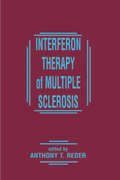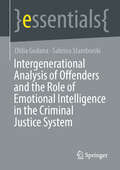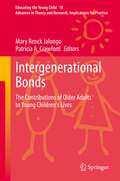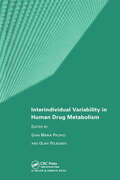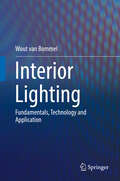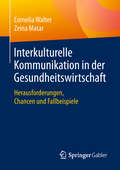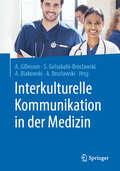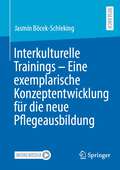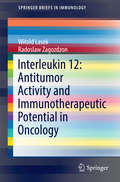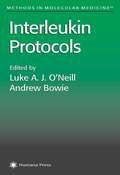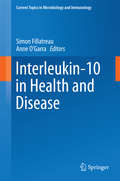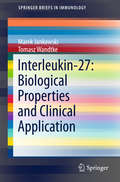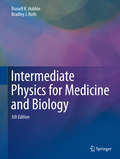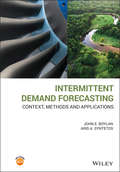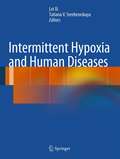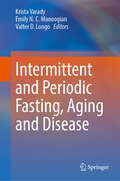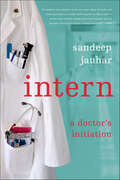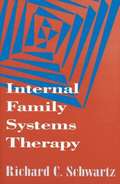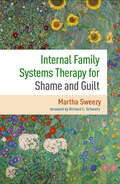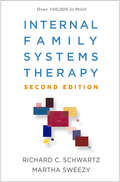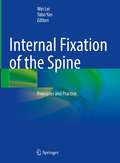- Table View
- List View
Interferon Therapy of Multiple Sclerosis
by Anthony T. RederThis reference presents cutting-edge basic and clinical research on all forms of interferon (IFN) involvement in the management of multiple sclerosis (MS)-detailing topics from IFN-receptor molecular interactions to synergy and interference with other agents such as cytotoxic drugs and chemotherapy. Features detailed research findings on IFN-1a (
Intergenerational Analysis of Offenders and the Role of Emotional Intelligence in the Criminal Justice System (essentials)
by Otilia Gudana Sabrina StamborskiIn 1996, violence was declared and identified as a global health problem. The risk of homicide and suicide reached epidemic proportions and affected specific population groups, including youths and members of minority groups. The suicide rates among adolescents and young adults (ages 15 to 24) nearly tripled between 1950 and 1990. Similarly, the homicide rates among males aged 15 to 19 almost doubled from 1985 to 1991. These trends raised global alarm and demanded new solutions. The motivation behind this book was to compare the level of emotional intelligence of criminals in prisons and forensic psychiatric facilities. The main objective of this analysis is to focus on recommendations for emotional intelligence training to reduce the epidemic rates of violence among inmates on a global level.
Intergenerational Bonds: The Contributions of Older Adults to Young Children's Lives (Educating the Young Child #18)
by Mary Renck Jalongo Patricia A. CrawfordThis book studies the many different ways in which the lives of the first, third, and fourth generations intersect and the reciprocal benefits that can accrue from establishing positive intergenerational bonds. The unifying feature across the chapters is that the authors view these relationships as a powerful influence on Quality of Life (QoL). The book takes the stance that older adults figure prominently in the QoL of young children, with the latter group defined here as ranging in age from infancy up to and including eight years of age. It examines how bonds with older adults can affect young children’s functioning across developmental domains—physical, emotional, social, and cognitive. It addresses questions of importance to those who have a commitment to the very young such as: “What benefits can young children derive from positive bonds with older adults?”, “How do young children understand the aging process and develop respect for the elderly?”, “How can published research be used to guide both informal and formal interactions between the older generation and the newest one?” and, finally, “How can various stakeholders such as professionals, families, organizations, and communities collaborate to enrich and enlarge the kind and amount of support that older adults provide to the very young child?”
Interim Report of the Committee on Geographic Variation in Health Care Spending and Promotion of High-Value Health Care
by Institute of MedicineInterim Report of the Committee on Geographic Variation in Health Care Spending and Promotion of High-Value Health Care: Preliminary Committee Observations is designed to provide the committee's preliminary observations for the 113th Congress as it considers further Medicare reform. This report contains only key preliminary observations related primarily to the committee's commissioned analyses of Medicare Parts A (Hospital Insurance program), B (Supplementary Medical Insurance program) and D (outpatient prescription drug benefit), complemented by other empirical investigations. It does not contain any observations related to the committee's commissioned analyses of the commercial insurer population, Medicare Advantage, or Medicaid, which will be presented in the committee's final report after completion of quality-control activities. This interim report excludes conclusions or recommendations related to the committee's consideration of the geographic value index or other payment reforms designed to promote highvalue care. Additional analyses are forthcoming, which will influence the committee's deliberations. These analyses include an exploration of how Medicare Part C (Medicare Advantage) and commercial spending, utilization, and quality vary compared with, and possibly are influenced by, Medicare Parts A and B spending, utilization, and quality. The committee also is assessing potential biases that may be inherent to Medicare and commercial claims-based measures of health status. Based on this new evidence and continued review of the literature, the committee will confirm the accuracy of the observations presented in this interim report and develop final conclusions and recommendations, which will be published in the committee's final report.
Interindividual Variability in Human Drug Metabolism
by O. Pelkonen G. M. PacificiThe book provides an exhaustive, authoritative and updated review on the interindividual variability in drug metabolism in humans. Four chapters address the general background: genetic factors causing variability, interethnic variability, environmental factors and developing and ageing as sources of variability. Six chapters address variability of
Interior Design: Theory and Process
by Anthony SullySuccessful interior design requires resolving a multitude of logistical and creative problems to produce a coherent, functional and aesthetically pleasing environment. This book, the first of its kind, tackles the problem from a theoretical approach and not in the conventional how-to or inspiring ideas fashion. Categorising design into nine key elements, including space, light, display, storage, and offering new terminology to describe each area, the author breaks new ground in the field of interior design in an approach that brings vitality and clear communication to a misunderstood and often free-wheeling design discipline. Drawing on more than 45 years' experience as an interior designer, Anthony Sully provides the ultimate resource in insight and explains best practices from interpreting a client's brief, to analysing the building, to setting up a design team and work schedule plus a host of other practical aspects. Peppered through this toolkit are illustrations and explanations of how to analyse space and form in relation to human activity, the formulation of design concepts, and how to learn from mistakes that have been made in the past.
Interior Lighting: Fundamentals, Technology and Application
by Wout van BommelThis book outlines the underlying principles on which interior lighting should be based, provides detailed information on the lighting hardware available today and gives guidance for the design of interior lighting installations resulting in good visual performance and comfort, alertness and health.The book is divided into three parts. Part One discusses the fundamentals of the visual and non-visual mechanisms and the practical consequences for visual performance and comfort, for sleep, daytime alertness and performance, and includes chapters on age effects, therapeutic effects and hazardous effects of lighting. Part Two deals with the lighting hardware: lamps (with emphasis on LEDs), gear, drivers and luminaires including chapters about lighting controls and LEDs beyond lighting. Part Three is the application part, providing the link between theory and practice and supplying the reader with the knowledge needed for lighting design. It describes the relevant lighting criteria for good and efficient interior lighting and discusses the International, European and North American standards and recommendations for interior lighting.A particular focus is on solid state light sources (LEDs) and the possibility to design innovative, truly-sustainable lighting installations that are adaptable to changing circumstances. The design of such installations is difficult and the book offers details of the typical characteristics of the many different solid state light sources, and of the aspects determining the final quality of interior lighting.Essential reading for interior lighting designers, lighting engineers and architects, the book will also be a useful reference for researchers and students.Reviews of Road Lighting by the same author:"If you are going to design streetlighting, you must read this book....a solid, comprehensive textbook written by an acknowledged expert in the field – if you have a query about any aspect of streetlighting design, you will find the answer here.” – LUX, August 2015 “…a realy comprehensive book dealing with every aspect of the subject well…essential text for reference on this subject” – Lighting Journal, March 2015
Interkulturelle Kommunikation in der Gesundheitswirtschaft: Herausforderungen, Chancen und Fallbeispiele
by Cornelia Walter Zeina MatarDieses Fachbuch, das auch zur Lehre eingesetzt werden kann, sensibilisiert für die besonderen Aspekte der interkulturellen Kommunikation in der Gesundheitswirtschaft vor dem Hintergrund der allgemeinen Internationalisierung und ermöglicht, die darin liegenden Herausforderungen und Chancen zu erkennen. Das Aufeinandertreffen unterschiedlicher Kulturen mag in anderen Branchen auch eine Herausforderung darstellen, doch ein kulturell geprägtes Verständnis von Gesundheit und Krankheit sowie von der Behandlung von Krankheiten und unterschiedliche Berufsausbildungen prägen die Zusammenarbeit zwischen Patienten und Leistungserbringern in der Gesundheitswirtschaft, die zudem in einem Abhängigkeitsverhältnis zueinander stehen.Zahlreiche Praxisbeispiele gewähren Einblick in konkrete Alltagssituationen, in denen die interkulturelle Kommunikation gut oder weniger gut funktioniert. Sie ermöglichen, spezifische Rahmenbedingungen zu erkennen und zu reflektieren. Die Autorinnen erläutern Möglichkeiten einer erfolgreichen interkulturellen Kommunikation in bestimmten Situationen der Gesundheitswirtschaft und zeigen auf, wie interkulturelle Kompetenz der Beschäftigten als Grundlage für produktive Zusammenarbeit entwickelt werden kann. Die Konzeption einer Diversity-Strategie für Organisationen im Gesundheitswesen rundet das Buch ab.
Interkulturelle Kommunikation in der Medizin
by Anton Gillessen Solmaz Golsabahi-Broclawski André Biakowski Artur BroclawskiDas Buch zeigt aus multiperspektivischer Sicht, wie elementar die interkulturelle Kommunikation auf Augenhöhe für ein vertrauensvolles Arzt-Patienten-Verhältnis im Praxis- und Klinikalltag ist. Ein Buch für Ärzte und Psychologen, das darüber hinaus alle Berufsgruppen in der Sozial- und Integrationsarbeit anspricht.Ausgehend von den aktuellen Erkenntnissen der internationalen Migrationsforschung werden dem Leser Wertevorstellungen und Verhaltensschemata in der Kommunikation zwischen Ärzten, Integrationshelfern und Menschen mit Zuwanderungshintergrund aufgezeigt. Im Fokus stehen dabei kultur-, sozial- und religionsanthropologischen Aspekte, die für die Integration von Flüchtlingen, Migranten und Spätaussiedlern im Kontext des Gesundheitswesens relevant sind. Anhand von Fallbeispielen bietet das Buch für verschiedene medizinische Fachgebiete praktische Handlungsempfehlungen für eine kultursensible und gleichberechtigte Arzt-Patienten-Beziehung.
Interkulturelle Trainings - Eine exemplarische Konzeptentwicklung für die neue Pflegeausbildung
by Jasmin Böcek-Schleking„Das Zusammenleben auf der Grundlage erheblicher kultureller Differenzen gilt bis heute nicht nur als möglicherweise hoch attraktiv, sondern auch als eine Herausforderung besonderer Art. Kulturelle Differenz steht für Faszination ebenso wie für Ängste, Abjektionen und andere negative Affekte oder allerlei Schwierigkeiten in der konkreten interkulturellen Praxis. Dies gilt für die Kommunikation, Kooperation und Koexistenz in privaten Handlungsfeldern ebenso wie in beruflichen. Die Pflege unterschiedlicher bedürftiger Gruppen gehört in diesen zweiten Bereich. Frau Böcek-Schleking widmet sich in ihrer hoch interessanten Masterarbeit interkulturellen Trainings, die im Rahmen der neuen Pflegeausbildung konzipiert wurden oder besser: konzipiert und eingesetzt werden sollen. Sie trägt damit nicht nur zur Reflexion und Weiterentwicklung bereits bestehender Konzepte bzw. zur Anwendung bewährter Theorien und Begriffe bei, sondern entwirft in ihrer eigenen Arbeit auf fundierten theoretischen Grundlagen und mit methodischem Sachverstand selbst ein solches Training, das sehr genau an die Anforderungen im genannten Praxisbereich „Pflege“ angepasst ist“ (Prof. Dr. Jürgen Straub).
Interleukin 12: Antitumor Activity and Immunotherapeutic Potential in Oncology
by Witold Lasek Radoslaw ZagozdzonThis book discusses the immunotherapeutic potential of Interleukin 12 in the context of clinical oncology, as well as antitumor effects confirmed in preclinical studies and clinical trials in cancer immunotherapy. Due to its ability to activate both innate (NK cells) and adaptive (cytotoxic T lymphocytes) immunities, Interleukin 12 (IL-12) has been regarded as a promising candidate for tumor immunotherapy. However, despite the encouraging results in animal models, only very modest antitumor effects have been confirmed in early clinical trials. Recently, several clinical studies have been initiated in which IL-12 was applied as an adjuvant in cancer vaccines, in gene therapy including locoregional injections of IL-12 plasmid, and in the form of tumor-targeting immunocytokines (IL-12 fused to monoclonal antibodies).
Interleukin Protocols
by Andrew Bowie Luke A. O’neillLuke O'Neill and Andrew Bowie bring together a collection of standard and advanced methods for measuring these powerful agents. Their readily reproducible techniques range from the assay of interleukin protein and mRNA-using ELISA, FACS, and RT-PCR-to the study of interleukin signal transduction. Newer techniques are also covered, including the analysis of interleukin gene polymorphisms and the use of cDNA microarrays. Many of the assays are geared to specific pathologies, including breast cancer, depression, psoriasis, Grave's disease, migraine, and myocardial infarction. Comprehensive and highly practical, Interleukin Protocols offers biomedical investigators a stellar collection of all the major techniques needed to analyze the role of interleukins in disease, to improve diagnosis, and to foster the rapid emergence of new and more powerful therapeutics.
Interleukin-10 in Health and Disease
by Simon Fillatreau Anne O'GarraThis volume provides a set of reviews dedicated to the biology of Interleukin (IL)-10. It includes chapters on its importance for maintaining immune homeostasis in humans, its role in intestinal immunity and its functions during viral and bacterial infections. In addition, it presents reviews on the mechanisms linking innate microbial recognition to the production of IL-10 and on how IL-10 recognition by its receptor functions. The roles of T and B cells as relevant sources of IL-10 are also discussed, with an emphasis on the clinical opportunities offered by IL-10-producing Tr1 cells for the suppression of unwanted immunity. Finally, the functions of other cytokines of the IL-10 family are presented. Collectively, these articles provide a comprehensive overview of our current knowledge on one of the most important anti-inflammatory cytokines known to date.
Interleukin-27: Biological Properties and Clinical Application
by Marek Jankowski Tomasz WandtkeThis volume focuses on various aspects of interleukin-27 (IL-27), especially its potential for clinical applications. The authors discuss the downstream signaling from the IL-27 receptor and its molecular targets in immune cells including Th1, Th2, Th17, Treg, Tr1, Tfh, B cells, DCs and macrophages. The inhibition of Th17 cells by IL-27 is vital for the maintenance of the feto-maternal tolerance and the prevention of lupus, multiple sclerosis, autoimmune uveitis, immune thrombocytopenia and atherosclerosis. However, the same inhibitory capabilities compromise the immune response to bacterial pathogens, and IL-27 is a pathogenic factor in sepsis and tuberculosis. Also covered are the conflicting reports on the role of IL-27 in rheumatoid arthritis, the effect of IL-27 on epithelia, which seems to play a role in asthma, psoriasis and inflammatory bowel diseases, and the direct cytotoxic and anti-vascular effects of IL-27, which make it a promising agent for the treatment of cancer. Accordingly, this volume will be of interest to researchers and clinicians alike.
Intermediate Medical Spanish: A Healthcare Workers’ Guide for Communicating With the Latino Patient
by Segal Diana Ruggiero (Galarreta-Aima)This is an intermediate/advanced level textbook directed toward students who are interested in learning the necessary medical terminology and cultural sensitivity to successfully care for the U.S. Spanish-speaking community in medical contexts. This textb
Intermediate Physics for Medicine and Biology
by Russell K. Hobbie Bradley J. RothThis classic text has been used in over 20 countries by advanced undergraduate and beginning graduate students in biophysics, physiology, medical physics, neuroscience, and biomedical engineering. It bridges the gap between an introductory physics course and the application of physics to the life and biomedical sciences. Extensively revised and updated, the fifth edition incorporates new developments at the interface between physics and biomedicine. New coverage includes cyclotrons, photodynamic therapy, color vision, x-ray crystallography, the electron microscope, cochlear implants, deep brain stimulation, nanomedicine, and other topics highlighted in the National Research Council report BIO2010. As with the previous edition, the first half of the text is primarily biological physics, emphasizing the use of ideas from physics to understand biology and physiology, and the second half is primarily medical physics, describing the use of physics in medicine for diagnosis (mainly imaging) and therapy. Among the many topics carried forward are thorough treatments of forces in the skeletal system, fluid flow, the logistic equation, scaling, equilibrium in statistical mechanics, the chemical potential and free energy, transport, membranes and osmosis, magnetic and electrical signals from nerves and the heart, membranes and gated channels in membranes, biological magnetic fields, linear and nonlinear feedback systems, including biological clocks and chaotic behavior, biological signal analysis, hearing and medical ultrasound, atoms and light, optical coherence tomography, radiometry and photometry, the interaction of photons and charged particles in tissue, radiological physics and the use of x-rays in diagnosis and therapy, nuclear medicine, and magnetic resonance imaging. Discussion of theory is closely linked to experiment. Prior courses in physics and in calculus are assumed. Intermediate Physics for Medicine and Biology, Fifth Edition is also ideal for self study and as a reference for workers in medical and biological research. Over 850 problems test and enhance the student's understanding and provide additional biological examples. A solutions manual is available to instructors. Each chapter has an extensive list of references.
Intermittent Demand Forecasting: Context, Methods and Applications
by John E. Boylan Aris A. SyntetosINTERMITTENT DEMAND FORECASTING The first text to focus on the methods and approaches of intermittent, rather than fast, demand forecasting Intermittent Demand Forecasting is for anyone who is interested in improving forecasts of intermittent demand products, and enhancing the management of inventories. Whether you are a practitioner, at the sharp end of demand planning, a software designer, a student, an academic teaching operational research or operations management courses, or a researcher in this field, we hope that the book will inspire you to rethink demand forecasting. If you do so, then you can contribute towards significant economic and environmental benefits. No prior knowledge of intermittent demand forecasting or inventory management is assumed in this book. The key formulae are accompanied by worked examples to show how they can be implemented in practice. For those wishing to understand the theory in more depth, technical notes are provided at the end of each chapter, as well as an extensive and up-to-date collection of references for further study. Software developments are reviewed, to give an appreciation of the current state of the art in commercial and open source software. “Intermittent demand forecasting may seem like a specialized area but actually is at the center of sustainability efforts to consume less and to waste less. Boylan and Syntetos have done a superb job in showing how improvements in inventory management are pivotal in achieving this. Their book covers both the theory and practice of intermittent demand forecasting and my prediction is that it will fast become the bible of the field.” —Spyros Makridakis, Professor, University of Nicosia, and Director, Institute for the Future and the Makridakis Open Forecasting Center (MOFC). “We have been able to support our clients by adopting many of the ideas discussed in this excellent book, and implementing them in our software. I am sure that these ideas will be equally helpful for other supply chain software vendors and for companies wanting to update and upgrade their capabilities in forecasting and inventory management.”—Suresh Acharya, VP, Research and Development, Blue Yonder. “As product variants proliferate and the pace of business quickens, more and more items have intermittent demand. Boylan and Syntetos have long been leaders in extending forecasting and inventory methods to accommodate this new reality. Their book gathers and clarifies decades of research in this area, and explains how practitioners can exploit this knowledge to make their operations more efficient and effective.”—Thomas R. Willemain, Professor Emeritus, Rensselaer Polytechnic Institute.
Intermittent Hypoxia and Human Diseases
by Lei Xi Tatiana V. SerebrovskayaIntermittent hypoxia can cause significant structural and functional impact on the systemic, organic, cellular and molecular processes of human physiology and pathophysiology. This book focuses on the most updated scientific understanding of the adaptive (beneficial) and maladaptive (detrimental) responses to intermittent hypoxia and their potential pathogenetic or prophylactic roles in the development and progression of major human diseases. This is a comprehensive monograph for clinicians, research scientists, academic faculty, postgraduate and medical students, and allied health professionals who are interested in enhancing their up-to-date knowledge of intermittent hypoxia research and its translational applications in preventing and treating major human diseases.
Intermittent and Periodic Fasting, Aging and Disease
by Krista Varady Emily N. C. Manoogian Valter D. LongoThis book is a comprehensive exploration of the science and clinical applications of fasting, with a particular focus on its effects on body weight and metabolic disease risk factors. It delves into various fasting methods, including time-restricted eating, intermittent fasting, alternate day fasting, and periodic fasting.The key concepts explored in this book include the physiological and cellular adaptations to different types of fasting, their impact on body weight and metabolic health, and their potential role in longevity, aging and disease prevention. The book addresses critical questions such as: What are the safety and efficacy of time-restricted eating? How does alternate day fasting affect body weight and metabolic disease risk factors? What are the evolutionary perspectives explaining the clinical benefits of periodic fasting? And how effective is periodic fasting in treating human chronic diseases? This book is aimed at healthcare professionals, researchers, nutritionists, and anyone interested in understanding the science behind fasting. Readers with a scientific or professional background will appreciate the rigorous research and clinical studies presented in this book. They will learn about the latest findings in this field and gain a deeper understanding of how different types of fasting can impact health, wellbeing and aging.
Intern: A Doctor's Initiation
by Sandeep JauharIntern is Sandeep Jauhar's story of his days and nights in residency at a busy hospital in New York City, a trial that led him to question our every assumption about medical care today. Residency—and especially the first year, called internship—is legendary for its brutality. Working eighty hours or more per week, most new doctors spend their first year asking themselves why they wanted to be doctors in the first place.Jauhar's internship was even more harrowing than most: he switched from physics to medicine in order to follow a more humane calling—only to find that medicine put patients' concerns last. He struggled to find a place among squadrons of cocky residents and doctors. He challenged the practices of the internship in The New York Times, attracting the suspicions of the medical bureaucracy. Then, suddenly stricken, he became a patient himself—and came to see that today's high-tech, high-pressure medicine can be a humane science after all.Now a thriving cardiologist, Jauhar has all the qualities you'd want in your own doctor: expertise, insight, a feel for the human factor, a sense of humor, and a keen awareness of the worries that we all have in common. His beautifully written memoir explains the inner workings of modern medicine with rare candor and insight.
Internal Family Systems Therapy
by Richard C. SchwartzMost theorists who have explored the human psyche have viewed it as inhabited by subpersonalities. Beginning with Freud's description of the id, ego, and superego, these inner entities have been given a variety of names, including internal objects, ego states, archetypes and complexes, subselves, inner voices, and parts. Regardless of name, they are depicted in remarkably similar ways across theories and are viewed as having powerful effects on our thoughts and feelings.In his important new book, Richard C. Schwartz applies systems concepts of family therapy to this intrapsychic realm. The result is a new understanding of the nature of people's subpersonalities and how they operate as an inner ecology, as well as a new method for helping people change their inner worlds. Called the Internal Family Systems (IFS) model, this approach is based on the premise that people's subpersonalities interact and change in many of the same ways that families or other human groups do. The model provides a usable map of this intrapsychic territory and explicates its parallels with family interactions.The IFS model can be used to illuminate how and why parts of a person polarize with one another, creating paralyzing inner alliances that resemble the destructive coalitions found in dysfunctional families. It can also be utilized to tap core resources within people. Drawing from years of clinical experience, the author offers specific guidelines for helping clients release their potential and bring balance and harmony to their subpersonalities so they feel more integrated, confident, and alive. Schwartz also examines the common pitfalls that can increase intrapsychic fragmentation and describes in detail how to avoid them. Finally, the book extends IFS concepts and methods to our understanding of culture and families, producing a unique form of family and couples therapy that is clearly detailed and has straightforward instructions for treatment.Offering a comprehensive approach to human problems that allows therapists to move fluidly between the intrapsychic and family levels, this book will appeal to both individual- and family-oriented therapists. Easily integrated with other orientations, the IFS model provides a nonpathologizing way of understanding problems or diagnoses, and a clearly delineated way to create an enjoyable, collaborative relationship with clients.
Internal Family Systems Therapy
by Richard C. SchwartzApplying family systems concepts to the intrapsychic realm, the Internal Family Systems (IFS) model proposes that individuals' subpersonalities interact and change in many of the same ways as do families and other human groups. Seasoned practitioner Richard C. Schwartz illuminates how parts of a person can form paralyzing inner alliances resembling the destructive coalitions found in dysfunctional families, and provides straightforward guidelines for incorporating the IFS model into treatment. A valuable text and clinical resource, the book demonstrates in step-by-step detail how therapists can help individuals, couples, and families tap core resources, bring balance and harmony to their subpersonalities, and feel more integrated, confident, and alive.intrapsychic territory and explicates its parallels with family interactions.The IFS model can be used to illuminate how and why parts of a person polarize with one another, creating paralyzing inner alliances that resemble the destructive coalitions found in dysfunctional families. It can also be utilized to tap core resources within people. Drawing from years of clinical experience, the author offers specific guidelines for helping clients release their potential and bring balance and harmony to their subpersonalities so they feel more integrated, confident, and alive. Schwartz also examines the common pitfalls that can increase intrapsychic fragmentation and describes in detail how to avoid them. Finally, the book extends IFS concepts and methods to our understanding of culture and families, producing a unique form of family and couples therapy that is clearly detailed and has straightforward instructions for treatment.Offering a comprehensive approach to human problems that allows therapists to move fluidly between the intrapsychic and family levels, this book will appeal to both individual- and family-oriented therapists. Easily integrated with other orientations, the IFS model provides a nonpathologizing way of understanding problems or diagnoses, and a clearly delineated way to create an enjoyable, collaborative relationship with clients.
Internal Family Systems Therapy for Shame and Guilt
by Martha SweezyRich in clinical examples, this book offers a fresh perspective on the roles of shame and guilt in psychological distress and presents a step-by-step framework for treatment. Martha Sweezy explains how the principles of Internal Family Systems (IFS) therapy are ideally suited to helping trauma survivors and other clients who struggle with debilitating shame to understand and heal psychic parts wounded in childhood. Annotated case illustrations show and explain IFS techniques in action. Other useful features include boxed therapeutic exercises, decision trees, and pointers to help therapists avoid or overcome common pitfalls.
Internal Family Systems Therapy, Second Edition (Guilford Family Therapy Ser.)
by Richard C. Schwartz Martha SweezyNow significantly revised with over 70% new material, this is the authoritative presentation of Internal Family Systems (IFS) therapy, which is taught and practiced around the world. IFS reveals how the subpersonalities or "parts" of each individual's psyche relate to each other like members of a family, and how--just as in a family--polarization among parts can lead to emotional suffering. IFS originator Richard Schwartz and master clinician Martha Sweezy explain core concepts and provide practical guidelines for implementing IFS with clients who are struggling with trauma, anxiety, depression, eating disorders, addiction, and other behavioral problems. They also address strategies for treating families and couples. IFS therapy is listed in SAMHSA's National Registry of Evidence-Based Programs and Practices. New to This Edition *Extensively revised to reflect 25 years of conceptual refinement, expansion of IFS techniques, and a growing evidence base. *Chapters on the Self, the body and physical illness, the role of the therapist, specific clinical strategies, and couple therapy. *Enhanced clinical utility, with significantly more "how-to" details, case examples, and sample dialogues. *Quick-reference boxes summarizing key points, and end-of-chapter summaries.
Internal Fixation of the Spine: Principles and Practice
by Wei Lei Yabo YanThis book aims provides detailed description of the surgical technique of spine surgery through internal fixation. It illustrates pedicle screw entry site in each vertebra using excellently recorded photographs of vertebral specimens and 3D reconstructed images. In the first chapter, the authors illustrate the entry point of pedicle screw in the cadaveric vertebrae. From Chapter Two to Chapter Seventeen, the authors introduce sixteen kinds of approaches and instrumentations according to the cervical, thoracic and lumbar spine, for the management of spondylosis, trauma and deformity.
